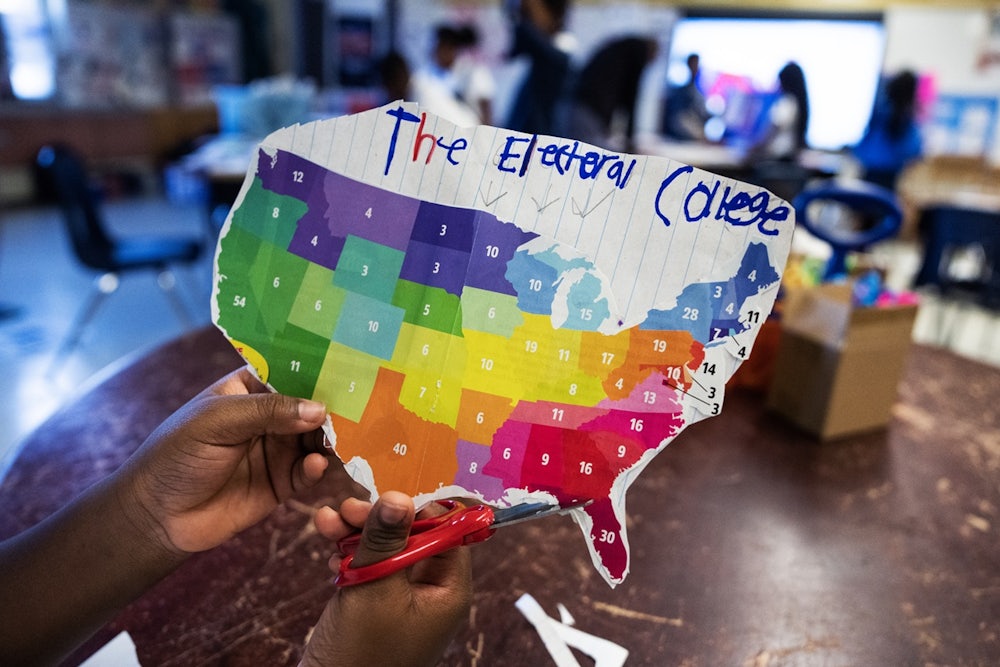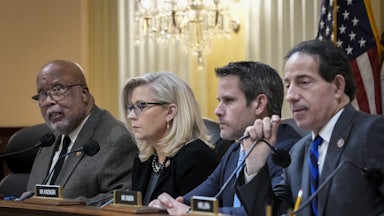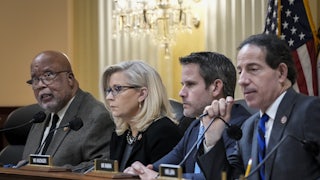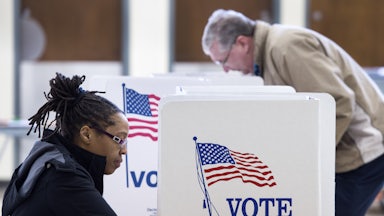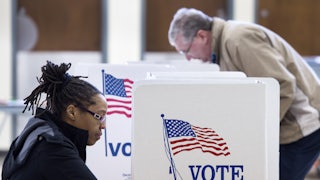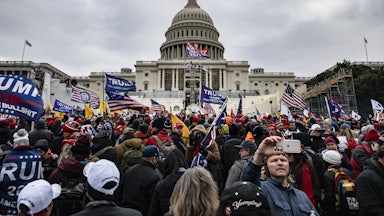Some political experts have been speculating that Donald Trump might win the popular vote in 2024 yet lose in the Electoral College, as Hillary Clinton did in 2016 and Al Gore in 2000 (and Grover Cleveland, Samuel Tilden, and Andrew Jackson before that).
I’m of two minds about this scenario. On one hand, if a plurality of Americans gives Trump their vote—it’s never happened before—that will say something about this country that I prefer not to believe. On the other hand, installing a Democrat in the White House who lacks a popular majority might finally persuade Republicans that passing a constitutional amendment to repeal the Electoral College—a change favored by 63 percent of Americans, according to a September Pew Research Center poll—is a reform that Republicans should favor. I’ve been arguing for decades that Democrats and Republicans share a common interest in abolishing the Electoral College. But Republicans will never believe it until the Electoral College bites them in the ass.
Speculation about an Electoral College victory for Kamala Harris even if she loses the popular vote arises from two polling developments: the likely closeness of the popular vote and some likely slippage in the Republican Party’s Electoral College advantage.
As a rule of thumb, the closer the popular vote gets, the less it matters who acquires the most votes and the more it matters where those votes reside. When a candidate wins the popular vote by, say, seven percentage points, as Barack Obama did in 2008—the last presidential contest one might fairly describe as a trouncing—you don’t have to look at the Electoral College results to know which candidate won.* But 2016 taught us that someone can win the popular vote by two percentage points and still lose in the Electoral College. Unless the polls have made a terrible hash of things, or unless we witness some 1980-style last-minute stampede, the winner this year will have a popular-vote margin much closer to two percentage points than seven.
As for the Republican Party’s Electoral College advantage, that was always a made-up thing—a probability calculated with a data set way too small to warrant one, measuring that most unpredictable of phenomena, human behavior. People believe in the Republican advantage because Trump won the presidency in 2016 without a popular-vote majority and because in 2020 Trump performed remarkably well in the Electoral College (though not well enough), even as President Joe Biden beat him in the popular vote by more than four percentage points.
Another reason people think the Electoral College favors Republicans is that the Republican George W. Bush won an Electoral College victory in 2000 even though he lost the popular vote to Al Gore (by less than one percentage point). Indeed, every president in American history who was denied the presidency despite winning the popular vote was a Democrat. This is sheer happenstance, but political experts have a hard time accepting the idea that anything is coincidental—specious determinism being an occupational hazard when you’re paid to fill dead air on television.
The myth of the GOP’s Electoral College advantage began to crumble in September 2023 when Nate Cohn of The New York Times (and formerly of The New Republic) crunched some numbers and found that this advantage, measured at 2.9 percentage points in 2016 and an even larger 3.8 points in 2020 (fat lot of good it did Trump), had dwindled to 0.7 points. (I won’t explain how this metric is calculated; Cohn does so here.) When Cohn checked in a year later, in September 2024, the GOP’s Electoral College advantage was still only 0.7 points. “It does not seem,” Cohn concluded, “that Kamala Harris will necessarily need to win the popular vote by much to prevail.” Over at The Atlantic, Ron Brownstein reached the same conclusion.
Late last month, Cohn took his argument one step further. It was now possible, Cohn wrote, that Trump would win the popular vote but lose in the Electoral College. No Republican has won the popular vote in three decades—the sole exception being George W. Bush in 2004—but some of those losses (Cohn pointed out) were razor-thin. Trump could win the popular vote, Cohn wrote, but still lose in the Electoral College vote because the votes Trump was picking up weren’t in the right places. Trump’s rising support among Blacks and Latinos, for example, did him little good in the Midwestern battleground states, because Blacks and Latinos were underrepresented there.
CNN’s data reporter Harry Enten and Politico’s Jeff Greenfield concluded much the same as Cohn. FiveThirtyEight, meanwhile, became hypnotized by scenarios where Harris and Trump tied in the Electoral College, 269–269, throwing the election into the House of Representatives. That too threw cold water on the idea that Republicans enjoy any lingering Electoral College advantage.
By now, dear reader, you’re getting impatient with me because I haven’t addressed the main reason everybody thinks the Electoral College favors Republicans: the small-state advantage. Small states enjoy disproportionate clout in the Electoral College because every state gets one elector per congressional district plus two. Thus, with not quite 600,000 residents, deep-red Wyoming, the least-populous among the 50 states, gets three electors, which is about twice as many as New Haven, Connecticut—even though New Haven has the same population. To add insult to injury, New Haven must share its 1.4 electors with nearby Middletown and Stratford. So yes, the small-state advantage is real.
But it isn’t especially Republican. The idea that states with teensy populations are all red, or even mostly red, is a myth. The second-least-populous of the 50 states is Vermont, with a population of not quite 650,000, and Vermont (three electors) hasn’t voted Republican in a presidential election since 1988. Of the 10 smallest states, all with three or four electors, five are red—Wyoming, Alaska, the Dakotas, and Montana—and five are blue—Vermont, Delaware, Rhode Island, Maine, and New Hampshire. Add in the deep-blue District of Columbia (three electors) plus the remaining four-elector states—blue Hawaii, red Idaho, and red West Virginia—and the score evens up again: seven Republican states to seven Democratic states or territories. (The District is the only U.S. territory that’s permitted to vote for president in the general election, though all of them hold primaries.)
Nor is it true anymore that the states with the largest populations are invariably blue. To be sure, the biggest state, California, is so blue that no Republican has held statewide office there for nearly 14 years. But the second- and third-biggest states, Texas and Florida, are red. Among the top 10, four are red, three are blue, and three (Pennsylvania, Michigan, and Georgia) are swing states. The Electoral College diminishes representation for big states, and yes, there was a time when those big states were mostly blue. But those days are over.
And anyway, the big states long ago figured out that they could even things up by awarding electors on a winner-take-all basis. Winner-take-all seldom comes up in arguments about whether to write the Electoral College out of the Constitution, because the allotment of electors isn’t a constitutional question; it’s up to the states whether to award electors proportionally (as they do in Maine and Nebraska) or winner-take-all (everywhere else). But winner-take-all disadvantages rural voters relative to urban voters, and even in red states that gives an extra boost to Democrats (though not so decisive a boost as it used to).
History does not relate which Founder at the Constitutional Convention of 1787 came up with the idea of an Electoral College to elect presidents; all we know is that it was the product of something called the Grand Committee on Postponed Questions. But James Madison bestowed his blessing on the Electoral College in Federalist 10. It was, Madison wrote, a method “to refine and enlarge the public views, by passing them through the medium of a chosen body of citizens, whose wisdom may best discern the true interest of their country, and whose patriotism and love of justice will be least likely to sacrifice it to temporary or partial considerations.”
Note that this is a MAGA fanatic’s worst nightmare of government by and for the elite. The Electoral College didn’t work out the way Madison described, partly because political parties emerged—they weren’t around in 1787—and partly because, almost immediately, states started making their electors winner-take-all, a development Madison deplored. But even if the United States had achieved the Enlightenment paradise of republican government that Madison envisioned, its appeal would have faded as the nation became ever more democratic, expanding the franchise in various ways and altering the Constitution to elect senators directly rather than through state legislatures. Nowadays the patrician spirit in which the Electoral College was created is as unattractive to liberals as it is to conservatives.
If Trump wins the popular vote and loses in the Electoral College, Republicans should finally become receptive to passing a constitutional amendment to eliminate it. Indeed, they might try to eliminate it retroactive to the 2024 election, something Republicans contemplated doing in 2000 when it looked briefly as though George W. Bush would win the popular vote and lose in the Electoral College. I don’t see how any such effort could get anywhere. But there’s a good chance Democrats and Republicans would come together to repeal the Electoral College before 2028. It would be the sole Trumpian desecration of our founding document with which liberals would enthusiastically agree—and it would happen without the unpleasantness of Trump being president.
* This post originally misidentified the date of the election.
